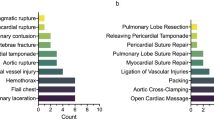Abstract
Background
Blunt cardiac injury (BCI) increases with traffic accidents and is an important cause of death in trauma patients. In particular, for patients who need surgical treatment, the mortality rate is extremely high unless the patient is promptly operated on. This study aimed to explore early recognition and expeditious surgical intervention to increase survival.
Methods
All patients with BCIs during the past 15 years were reviewed, and those who underwent operative treatment were analyzed retrospectively regarding the mechanism of injury, diagnostic and therapeutic methods, and outcome.
Results
A total of 348 patients with BCIs accounted for 18.3% of 1903 patients with blunt thoracic injury (BTI). Of 348 patients, 43 underwent operative treatment. The main cause of injury was traffic accidents, with an incidence of 48.8%. Of them, steering wheel injuries occurred in 15 patients. In 26 patients, a preoperative diagnosis was obtained by echocardiography, CT scanning, etc. In the remaining 17, who had to undergo urgent thoracotomy without any preoperative imaging, a definitive diagnosis of BCI was proven during the operation. The volume of preoperative infusion or crystalloid was <1000 ml in 31 cases. Preoperative pericardiocentesis was not used in anyone. In 12 patients, the operation commenced within 1 h. Overall mortality was 32.6%. The death was caused by BCI in 9.
Conclusions
Facing a patient with BTI, a high index of suspicion for BCI must be maintained. To manage those requiring operations, early recognition and expeditious thoracotomy are essential. Preoperatively, limited fluid resuscitation is emphasized. We do not advocate preoperative pericardiocentesis.





Similar content being viewed by others
References
Emet M, Akoz A, Aslan S et al (2010) Assessment of cardiac injury in patients with blunt chest trauma. Eur J Trauma Emerg Surg 36:441–447. https://doi.org/10.1007/s00068-010-0005-1
Skinner DL, Laing GL, Rodseth RN et al (2015) Blunt cardiac injury in critically ill trauma patients: a single centre experience. Injury 46:66–70. https://doi.org/10.1016/j.injury.2014.08.051
Chai HS, Lee SW, Park JS et al (2018) Cardiac arrest associated with aortic valve regurgitation. Am J Emerg Med 36:345.e1–345.e3. https://doi.org/10.1016/j.ajem.2017.11.040
Belliister SA, Dennis BM, Guillamondegui OD (2017) Blunt and penetrating cardiac trauma. Surg Clin North Am 97:1065–1076. https://doi.org/10.1016/j.suc.2017.06.012
Marcolini EG, Keegan J (2015) Blunt cardiac injury. Emerg Med Clin North Am 33:519–527. https://doi.org/10.1016/j.emc.2015.04.003
Yousef R, Carr JA (2014) Blunt cardiac trauma: a review of the current knowledge and management. Ann Thorac Surg 98:1134–1140. https://doi.org/10.1016/j.athoracsur.2014.04.043
Hammer MM, Raptis DA, Cummings KW et al (2016) Imaging in blunt cardiac injury: computed tomographic findings in cardiac contusion and associated injuries. Injury 47:1025–1030. https://doi.org/10.1016/j.injury.2015.11.008
Wall MJ, Mattox KL, Wolf DA (2005) The cardiac pendulun: blunt rupture of the pericardium with strangulation of the heart. J Trauma 59:136–142. https://doi.org/10.1097/01.TA.0000171466.47885.C5
Verma N, White CS, Mohanned TL (2018) Blunt cardiothoracic trauma: common injuries and diagnosis. Semin Roentgenol 53:171–177. https://doi.org/10.1053/j.ro.2018.02.007
Lindenmann J, Matzi V, Neuboeck N et al (2010) Traumatic pericardial rupture with cardiac herniation. Ann Thorac Surg 89:2028–2030. https://doi.org/10.1016/j.athoracsur.2009.10.048
Mattox KL, Flint LM, Carrico CJ et al (1992) Blunt cardiac injury. J Trauma 33:649–650
Gosavi S, Tyroch AH, Mukherjee D (2016) Cardiac trauma. Angiology 67:896–901. https://doi.org/10.1177/0003319715627954
Huis in’t Veld MA, Craft CA, Hood RE (2018) Blunt cardiac trauma review. Cardiol Clin 36:183–191. https://doi.org/10.1016/j.ccl.2017.08.010
Raptis DA, Bhalla S, Raptis CA (2019) Computed tomographic imaging of cardiac trauma. Radiol Clin North Am 57:201–212. https://doi.org/10.1016/j.rcl.2018.08.009
Verma N, Robinson JD, Gunn ML (2018) Pericardial rupture and cardiac herniation in blunt trauma. Radial Case Rep 13:573–575. https://doi.org/10.1016/j.radcr.2018.02.013
Nassiri N, Yu A, Statkus N et al (2009) Imaging of cardiac herniation in traumatic pericardial rupture. J Thorac Imaging 24:69–72. https://doi.org/10.1097/RTI.0b013e31818d12de
Burrell AJ, Kaye DM, Fitzgerald MC et al (2017) Cardiac magnetic resonance imaging in suspected blunt cardiac injury: a prospective, pilot, cohort study. Injury 48:1013–1019. https://doi.org/10.1016/j.injury.2017.02.025
Gao JM, Gao YH, Wei GB et al (2004) Penetrating cardiac wounds: principles for surgical management. World J Surg 28:1025–1029. https://doi.org/10.1007/s00268-004-7523-0
Soar J, Perkins GD, Abbas G et al (2010) European Resuscitation Council guidelines for resuscitation 2010: section 8. Cardiac arrest in special circumstances: electrolyte abnormalities, poisoning, drowning, accidental hypothermia, hyperthermia, asthma, anaphylaxis, cardiac surgery, trauma, pregnancy, electrocution. Resuscitation 81:1400–1433. https://doi.org/10.1016/j.resuscitation.2010.08.015
Demetriades D, van der Veen BW (1983) Penetrating injuries of the heart: experience over two years in South Africa. J Trauma 23:1034–1041
Mishra B, Gupta A, Sagar S et al (2016) Traumatic cardiac injury: experience from a level-1 trauma centre. Chin J Traumatol 19:333–336. https://doi.org/10.1016/j.cjtee.2016.08.001
Doi A, Lee CN, Leng SA et al (2012) Simple and quick repair of cardiac rupture due to blunt chest trauma. Asian Cardiovasc Thorac Ann 20:64–65. https://doi.org/10.1177/0218492311421444
Pinni S, Kumar V, Dharap SB (2016) Blunt cardiac rupture: a diagnostic challenge. J Clin Diagn Res 10:PD27–PD28. https://doi.org/10.7860/JCDR/2016/22220.8894
El-Menyar A, Al Thani H, Zarour A et al (2012) Understanding traumatic blunt cardiac injury. Ann Card Anaesth 15:287–295. https://doi.org/10.4103/0971-9784.101875
Bock JS, Benitez RM (2012) Blunt cardiac injury. Cardiol Clin 30:545–555. https://doi.org/10.1016/j.ccl.2012.07.001
Author information
Authors and Affiliations
Corresponding author
Ethics declarations
Conflict of interest
The authors have no conflict of interest to report and have received no financial or material support related to this manuscript.
Ethical approval
Because no human subjects were involved in the manuscript and because only deidentified data were used, the requirement for an ethical review and informed consent was waived by the Institutional Review Board of Chongqing Emergency Medical Center (CEMC), China.
Informed consent
Informed consent was obtained from all individual participants included in the study.
Additional information
The manuscript is dedicated to summarizing the clinical experiences of emergency blunt cardiac trauma patients who all received standard treatment, and this is a retrospective analysis. The paper involves no prospective clinical trials or recruitment of volunteers. Therefore, it is beyond the category of research that needs to be registered.
Publisher's Note
Springer Nature remains neutral with regard to jurisdictional claims in published maps and institutional affiliations.
Rights and permissions
About this article
Cite this article
Gao, JM., Du, DY., Kong, LW. et al. Emergency Surgery for Blunt Cardiac Injury: Experience in 43 Cases. World J Surg 44, 1666–1672 (2020). https://doi.org/10.1007/s00268-020-05369-6
Published:
Issue Date:
DOI: https://doi.org/10.1007/s00268-020-05369-6




